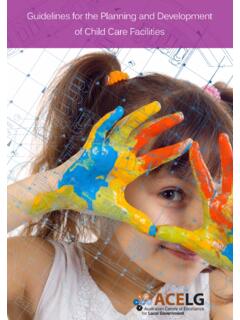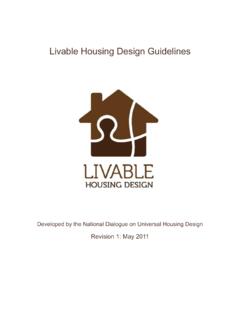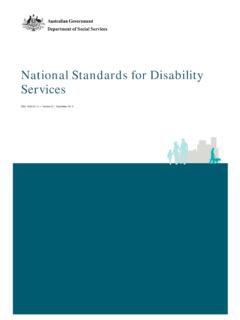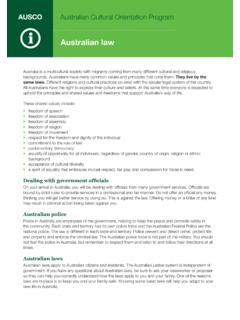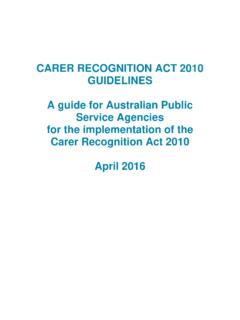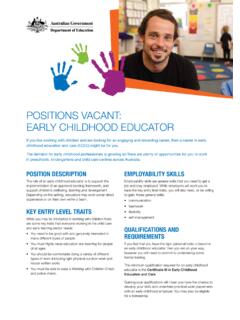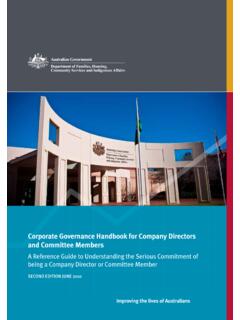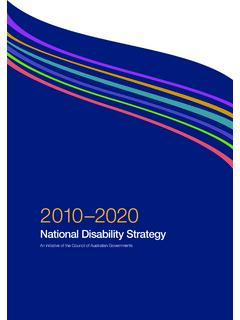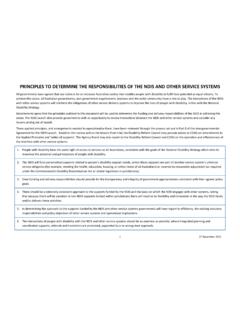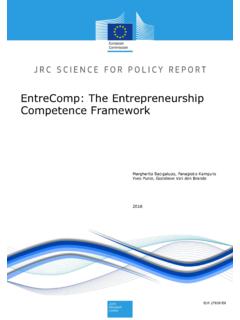Transcription of Literature Review: Effective interventions for working ...
1 Improving the lives of AustraliansLiterature Review: Effective interventions for working with young people who are homeless or at risk of opinions, comments and/or analysis expressed in this document are those of the author or authors and do not necessarily represent the views of the Minister for Families, Housing, community Services and Indigenous Affairs and cannot be taken in any way as expressions of government BY:Justin BarkerPeter HumphriesMorag McArthurLorraine ThomsonThis project was commissioned by the Australian Government Department of Families, Housing, community Services and Indigenous Affairs. Institute of Child Protection Studies Canberra Campus Australian Catholic University PO Box 256 DICKSON ACT 2602 Phone: 02 6209 1225 Fax: 02 6209 1216 Commons LicenceWith the exception of the Commonwealth Coat of Arms and where otherwise noted all material presented in this document is provided under a Creative Commons Attribution Australia licence ( ).
2 The details of the relevant licence conditions are available on the Creative Commons website (accessible using the links provided) as is the full legal code for the CC BY AU licence ( ). document must be attributed as the Department of Families, Housing, community Services and Indigenous Affairs [ Literature Review: Effective interventions for working with young people who are homeless or at risk of homelessness].Contact: Reconnect at FaHCSIA, PO BOX 7576, Canberra Business Centre, ACT, 2610, the lives of AustraliansLiterature Review: Effective interventions for working with young people who are homeless or at risk of Introduction 5 Youth Homelessness 6 Early Intervention 7 Families and Youth Homelessness 72.
3 Literature Review Strategy 8 Search Procedure 9 Assessing the Evidence 10 Limitations 113. Findings About What Works 11 The Centrality of Relationship 12 interventions for Addressing Multiple and Interlinked Factors 15 Case management 16 community Reinforcement Approach (CRA) 18 Wraparound 18 interventions at the Family Level 19 Specific Family Work Models 21 Multisystemic therapy (MST) 21 STRIVE 21 Family therapy 22 Family mediation 23 Narrative therapy 24 interventions with Individual Young People 25 Outreach or street-based youth work 25 Cognitive Behavioural therapy 26 Solution-focused Brief therapy 27 Motivational interventions 28 interventions with co-occurring mental health and AOD issues 29 Independent living skills training for young people leaving care 29 Interveneing to Promote community Level Protection Factors 31 School-based interventions 31 Group work 31 Vocational training 33 ContentsWhat works with Young People Already Homeless 33 Housing models 33 Indigenous homelessness and public place dwellers 37
4 Important Principals of Service Delivery 38 Relationships 38 Collaboration 38 Strength Based 39 Participation and Inclusion 39 Individually Responsive and Flexible 40 Capacity Building 41 Continuity of Care 42 Sustainability 424. Discussion 435. References 45 Literature Review: Effective interventions in working with young people who are homeless or at risk of homelessness11. IntroductionThis Literature review was commissioned by the Commonwealth Department of Families, Housing, community Services and Indigenous Affairs (FaHCSIA). The aim of the review is to assess the current state of evidence about what interventions are most Effective in working with young people who are homeless or at risk of homelessness.
5 This Literature review was produced in order to inform a broader project that identifies the range of interventions and strategies that are applied by Reconnect services and situates these practices within the existing evidence base (see separate report, Reconnect: working with young people who are homeless or at risk of homelessness). Reconnect is a community -based early intervention program for young people who are homeless or at risk of homelessness. It was established in 1998 as an early intervention response to youth homelessness. Reconnect uses early intervention strategies to help young people to stabilise and improve their housing, achieve family reconciliation, and improve their level of engagement with work, education, training and funds Reconnect services to deliver services to young people aged 12 18 years (newly arrived young people 12 21 years) who are homeless or at risk of homelessness, and their families.
6 Some Reconnect services focus on working with specific population groups, for example: Indigenous young people (Aboriginal or Torres Strait Islander people); young people experiencing mental health issues; and newly arrived young review is guided by the key research question: what are Effective intervention strategies for working with young people who are homeless or at risk of homelessness? The Literature review begins with a brief overview of youth homelessness as an issue of concern, its identified relevant risk and protective factors, and the relevance of early intervention. It then outlines the strategy for undertaking this Literature review and presents the findings of the homelessnessYouth homelessness continues to be a problem in modern Australian society and is emblematic of social inequality and injustice in an otherwise affluent society.
7 Research indicates that youth homelessness is related to a range of risk factors and harms that interact with each other in complex ways. Though the risks and pathways into homelessness are varied and multifaceted, research consistently highlights several, often overlapping, causal factors: family breakdown (including neglect, conflict and abuse); mental health issues; unemployment; poverty; alcohol and other drug issues; and crime (Barker, 2010; Homelessness Taskforce, 2008; National Youth Commission, 2008).2 Literature Review: Effective interventions in working with young people who are homeless or at risk of homelessness Particular population groups are over-represented in the homeless population and are at increased risk of homelessness, such as young people who have been in state care and protection and young people of Aboriginal and Torres Strait Islander descent (National Youth Commission, 2008).
8 There is increasing evidence that new arrivals to Australia and refugee young people are also at increased risk of homelessness (Association for Services to Torture and Trauma Survivors et al., 2008; Couch, 2011).Young people who become homeless are exposed to a range of conditions that put them at high risk of developing a host of negative health, social and economic outcomes (National Youth Commission, 2008). Homeless youth have increased susceptibility to substance abuse and dependence (Baer et al., 2003), mental health issues (N. Slesnick & J. Prestopnik, 2005), medical problems (Hudson et al., 2010; Kelly & Caputo, 2007), violence and victimisation (Baron, 2003, 2009). Homeless youth are consistently linked to disengagement with traditional social institutions and forms of support, such as family, school and other prosocial forms of social capital, such as community and peer groups (Heinze, Jozefowicz, & Toro, 2010).
9 The burden of harms linked to youth homelessness can cause significant cost to individuals, families and the younger someone is when they first become homeless, the more likely they are to remain homeless for a longer period of time. A large proportion of people who go on to become chronically homeless had their initial experience of homelessness before the age of 18 years (Chamberlain & Johnson, 2011). As in many other social problems like child abuse and neglect and youth offending (Hayes, 2004; Landy & Menna, 2006; National Crime Prevention, 1999), early intervention has been identified as important in preventing or reducing youth homelessness (Pawson et al., 2007).Early interventionThe earlier we intervene, the more likely we are to reduce homelessness and the social, emotional and health problems linked to it.
10 Effective early intervention which addresses risk factors such as family conflict, mental health issues, unemployment, poverty, alcohol and other drug issues and crime, and builds protective factors such as community connections and healthy family relationships leads to long-term benefits for young people, families and communities (Sanson et al., 2002). Early intervention can be early in the life of a child or early in the life of a problem (Little, 1999). Many of the harms associated with homelessness can be prevented or reduced by intervening early, utilising evidence-based strategies such as the Triple P parenting program (Sanders, Cann, & Markie- Dadds, 2003), as they can have their origins in childhood and adolescence.
